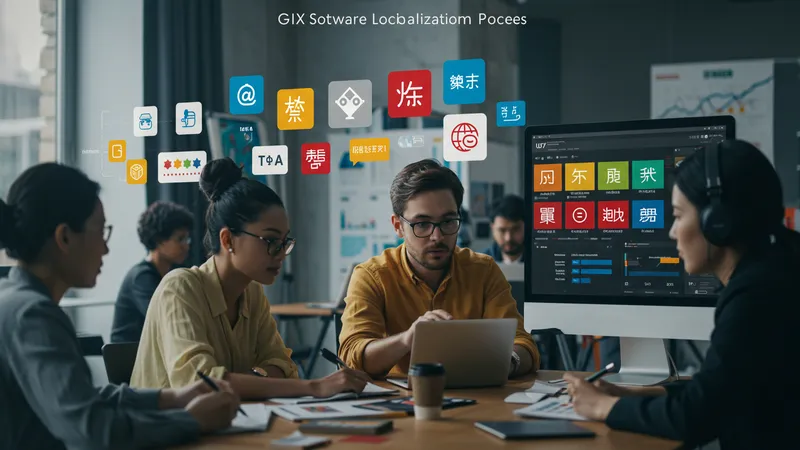

In today's digital landscape, expanding into new markets requires more than simple translation—you need a nuanced approach to adapting software products for multiple languages, cultures, and local expectations. This complex undertaking is known as software localization, a meticulous process that blends language expertise, engineering, and regional knowledge to deliver products that feel native to audiences worldwide. Global brands rely on specialized studios that combine translation precision with deep technical skills to ensure every element in the user journey resonates and operates seamlessly.
These studios manage everything from user interface text, error messages, and documentation to region-specific date formats and cultural references. Their expertise spans terminology consistency, in-context troubleshooting, right-to-left script handling, and integration with agile development cycles. The result? Software products that users around the world can intuitively experience in their preferred language, increasing engagement and satisfaction for global companies.

The landscape of software localization is defined by breadth and specialization. For instance, Lionbridge and TransPerfect are trusted by many of the world’s largest multinationals, handling hundreds of language pairs and working closely with development teams throughout the software lifecycle. Tools like Lokalise and Smartling cater to agile workflows, making it easier for fast-evolving SaaS teams to integrate localization into continuous deployment pipelines. Startups and app developers often turn to OneSky or Gengo for scalable and cost-effective approaches that don’t sacrifice quality for speed.
Each studio offers distinctive strengths: while RWS Group and its Moravia brand are acclaimed for handling complex technical projects, Weglot appeals due to its plug-and-play model that enables almost instant multilingual transformations. Meanwhile, Alconost stands out for transparent pricing and multilingual capabilities that cater to indie software and large-scale releases alike.
Global brands weigh multiple criteria when selecting a studio, from linguistic accuracy and cultural insight to scalability, API integrations, and speed of turnaround. Pricing can vary dramatically depending on the number of languages required, UI complexity, file formats, and whether ongoing maintenance is included. Studios commonly employ dedicated account managers and linguists native to each target market, providing both project oversight and invaluable cultural intelligence.
What makes a localization studio indispensable is not just linguistic expertise—it’s the blend of process automation, cross-functional support, and flexibility to pivot with technology trends. With cloud-based tools and AI-powered linguistic matching, these studios greatly accelerate releases for international audiences without sacrificing quality or consistency. The right partner can be the difference between lukewarm adoption overseas and viral global growth.
Choosing a localization studio is a strategic step that can reshape a brand’s international trajectory. But the initial list only scratches the surface—delving into their unique approaches, technology integrations, and regional know-how uncovers the true value they deliver for global brands. The deeper details reveal even more valuable insights ahead…
Software localization studios employ specialized platforms and integration tools to streamline workflows for global brands. Many, such as Smartling and Lokalise, offer cloud-based dashboards with automated string extraction, instant previews, and continuous workflow support. These tools enable developers and translators to collaborate in real time, reducing bottlenecks and ensuring that changes propagate quickly across all language versions. Tight integrations with repositories like GitHub and Bitbucket further accelerate release cycles, allowing for true agile localization.

Weglot stands out for its API-driven approach, offering direct integration with websites and applications through code snippets or plugins. This simplicity makes it attractive for brands looking for instant, scalable language support without complex infrastructure changes. On the other hand, larger agencies such as TransPerfect and Lionbridge invest in custom connectors and machine translation engines alongside human quality assurance, handling highly technical and regulated software products for industries like finance and legal.
Efficiency gains go beyond speed: many studios now deploy AI-powered translation memory systems. These learn from historical context, reusing consistent terminology and adapting local nuances as needed. As a result, brands benefit from increased accuracy and cost savings, particularly in software with frequent updates. Alconost and RWS Group have incorporated such technologies to ensure every release meets both linguistic and technical specifications across markets.
The push toward automation doesn’t eliminate the need for human expertise. Studios assign native-language linguists and regional consultants to review content, catching context-sensitive mistakes that machines can’t identify. This hybrid approach means global brands achieve accuracy and authenticity at scale, while reducing manual workload and turnaround times. It’s this fusion of automation and expert review that keeps industry leaders ahead in quality and speed.
For global brands, software localization is not just about linguistic conversion—it’s about delivering a user experience tailored to distinct cultures. Studios like Gengo and Alconost prioritize cultural adaptation, ensuring that interface layouts, icons, and color schemes resonate with local audiences. This could mean adjusting layouts for right-to-left languages such as Arabic or Hebrew, or adapting visuals that might carry unexpected meanings in certain regions.

TransPerfect and RWS Group employ regional UX consultants who test software versions with in-market users, gaining actionable feedback on navigation, tone, and even humor. For example, jokes or metaphors need careful reworking, and date/time formatting must align with local conventions. Features that feel intuitive in one culture might confuse users elsewhere—a challenge studios solve by involving diverse test panels during pre-launch phases.
Mobile and SaaS localization demands distinct strategies. OneSky and Weglot prioritize space efficiency and readability, often providing in-context character counts and dynamic previews for mobile screens. Even minor misalignments can disrupt the usability of an app—hence why top studios embed QA cycles directly into translation sprints to catch such nuances before release.
Cultural missteps can impact adoption rates and brand perception. Software localization studios reduce these risks by continuously investing in cross-cultural training for their teams and partnering with local experts. The brands that succeed globally are those that treat localization as a core user experience investment rather than a last-stage translation task.
Successful software localization projects rely on sophisticated project management and collaborative dynamics. Large studios like Lionbridge and Moravia assign dedicated account managers who coordinate across product teams, translators, QA experts, and localization engineers. This central point of contact ensures a unified strategy in handling evolving requirements and balancing multiple time zones for global release cycles.

Smartling and Lokalise use collaborative cloud environments where brand managers, developers, and linguists interact directly within the platform. This eliminates the delays of traditional handoffs, allowing immediate clarification on technical or contextual queries. Comment threads, change tracking, and automated alerts help align all stakeholders and prevent miscommunication during rapid iteration stages.
Studios such as TransPerfect and Alconost offer modular service models: clients can choose full-service project management or access specialized support for integration and QA only. This flexibility is crucial for brands with diverse product portfolios, as it allows scaling up or down based on the release schedule or region-specific needs.
Distributed project teams are now the norm, especially for handling multilingual launches. Gengo leverages crowdsourced linguist pools, assigning work simultaneously across multiple translators while maintaining strict version control. This distributed approach speeds up complex launches while ensuring consistency across all localizations. The best studios supplement streamlined platforms with rigorous project oversight, ensuring deadlines are met and quality remains high.
Evaluating the impact of localization involves tracking metrics such as localized user engagement, retention rates, and regional revenue growth. Top studios support brands in setting up analytics to compare user behavior across different languages and markets. For instance, Smartling and Lionbridge integrate with analytics platforms, making it possible to identify where localized interfaces are boosting sign-ups or reducing churn.

Continuous feedback loops are vital for sustained success. Studios like RWS Group and OneSky set up post-launch review phases where in-market users flag issues or suggest improvements. These insights feed directly into subsequent release cycles, ensuring that localization evolves alongside changing market expectations. Over time, brands experience compound improvements—both in user sentiment and product adoption.
Scaling effectively requires a blend of automation, trusted linguist networks, and adaptable workflows. Alconost and Gengo offer API-based solutions enabling brands to trigger translation jobs programmatically as new features roll out. Meanwhile, enterprise studios like TransPerfect provide 24/7 support, onboarding regional teams to handle spikes in demand and troubleshooting local issues before they create obstacles for users.
The global software ecosystem will only grow more complex and interconnected. By partnering with studios that combine advanced technology, local expertise, and flexible services, brands can ensure their products connect authentically with users everywhere. The art and science of software localization continues to evolve, shaping the success of global releases for the world’s most influential companies.